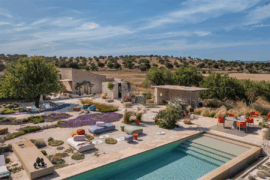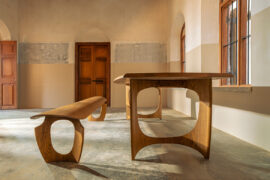Nearly 100 years on, the 1920s design boom continues to inspire. From around the world there was a multitude of experimental, beautiful and striking design trends….

March 23rd, 2018
1920s design was more than simply a movement or a particular style. With technology advancing and optimism at a global high after World War 1, the decade of the roaring 20s produced design like we’d never seen before. Movements and aesthetics from around the globe competed and borrowed from one another to create a wealth of styles that we still look to and love today. With this in mind, here are our five 1920s design icons we still love, nearly a hundred years later
While the style of art deco was originally a French pre-war creation it’s the decade of the 1920s that this architecture, art and design movement will always be associated with. Combining a suite of modernist styles with fine craftsmanship and rich materials, Art Deco represented luxury, glamour, exuberance, and optimism in social and technological progress after the war. A pastiche of many different styles, Art Deco’s aesthetic were united by a desire to be modern. Taking inspiration from the bold geometry of cubism, the bright colours of Fauvism and the luxury of old French rulers, art deco became one of the first truly international styles, and we still see it’s charm surviving today.
From New York’s iconic Chrysler Building and Radio City Music Hall, to always in vogue glass vase sculptures and even Sydney’s ANZAC War Memorial – Art Deco may have had its heyday in in the 1920s, but the style isn’t going anywhere.




Germany’s Staatliches Bauhaus, which operated from 1919, through the 1920s before being closed in 1933, remains one of the most important and influential design schools in the history of the 20th century. Established with the idea of creating a ‘total’ work of art, or Gesamtkunstwerk in German, the Bauhaus school created a style that is enduring and beloved even today. Quintessentially modern, the architecture, furniture, accessories and art the men and women of the Bauhaus school created exemplify not only the timeless beauty of the 1920s, but of 20th century and modernism in general




De Stijl, Dutch simply for The Style was a prominent architectural and artistic movement that originally referred to the work created in the Netherlands in the 1920s under a specific style. A style that advocates for the use of pure abstraction and universality – reducing objects to the bare essentials of form and colour. The result is the iconic black, white, red, blue, and yellow designs today that have been appropriated across fashion, music, style and more.
From the architecturally inspired paintings of Mondrian to the iconic Red and Blue Chair, designed by Gerrit Rietveld in 1923, the De Stijl aesthetic is a timeless expression of the purity of design. By removing all that’s not needed, the resulting designs cannot help but be timeless and suitable for a modern application.
Any discussion of De Stijl design cannot omit the iconic Rietveld Schröder House in Utrecht, Netherlands. Completed in 1924, the house is the purest example of De Stijl architecture, and having been named a UNESCO World Heritage site in 2000, it’s unsurprising it remains a beloved classic 20th century design, even after nearly a century.




Perhaps the icon of 20th century American architecture, the rise of the Skyscraper (pun only half intended) is one of the 1920s’ greatest success stories. Until the end of the 19th century, buildings of over a few storeys were quite rare, but with the development of steel, reinforced concrete, technology of elevators and water pumps, taller and taller buildings were possible.
The first skyscrapers appeared in the bustling cities that exemplified the spirit of the roaring 20s in the design. Chicago and New York. Employing mixes of largely neo-gothic and neoclassical style, the resulting 1920s design marvels are buildings that have shaped not only the spatial design of cities for the coming century but have changed our lives entirely. From how we live, work, sleep, play, eat and create, these marvels of engineering and design are perhaps the most important design idea to come from the 1920s, at least for city dwellers.




While the bombast and glamour of the art deco style dominated the luxury levels of design, it was muted colours and pared back style that defined 1920s design for much of the world. In 1920s America, interior paint styles moved away from the vivid tones of the previous century, and many colours popular during the 1920s became muted or somewhat washed out, containing significant amounts of grey. This minimalist style ran parallel to the Bauhaus design aesthetic without intentionally borrowing from it, and today – muted mauves, olive greens, peacock blues and faded reds paired with grey neutrals can set a timeless 1920s mood.




INDESIGN is on instagram
Follow @indesignlive
A searchable and comprehensive guide for specifying leading products and their suppliers
Keep up to date with the latest and greatest from our industry BFF's!

The undeniable thread connecting Herman Miller and Knoll’s design legacies across the decades now finds its profound physical embodiment at MillerKnoll’s new Design Yard Archives.

Intricate motifs imbued with Culture create stunning patterns in Willie Weston’s newest collection – sharing lost stories of Country from Gadigal artist Kate Constantine.
Emma Elizabeth from thedesignvlog.com starts off her Milan odyssey at Zona Tortona, where she checks out new work by Superstudio Piu, Moooi and Tom Dixon.
The internet never sleeps! Here's the stuff you might have missed

Entertaining outdoors is fundamental to Italian culture, and homes, hotels and restaurants embrace patios, terraces and gardens that celebrate scenery, climate and comfort.

Architect, designer and craftsman Adam Markowitz bridges the worlds of architecture and fine furniture, blending precision, generosity and advocacy to strengthen Australia’s craft and design community.

BVN’s Sirius Redevelopment has been named one of two joint winners of The Building category at the INDE.Awards 2025. Celebrated alongside Central Station by Woods Bagot and John McAslan + Partners, the project reimagines an iconic Brutalist landmark through a design approach that retains heritage while creating a vibrant, sustainable future for Sydney.